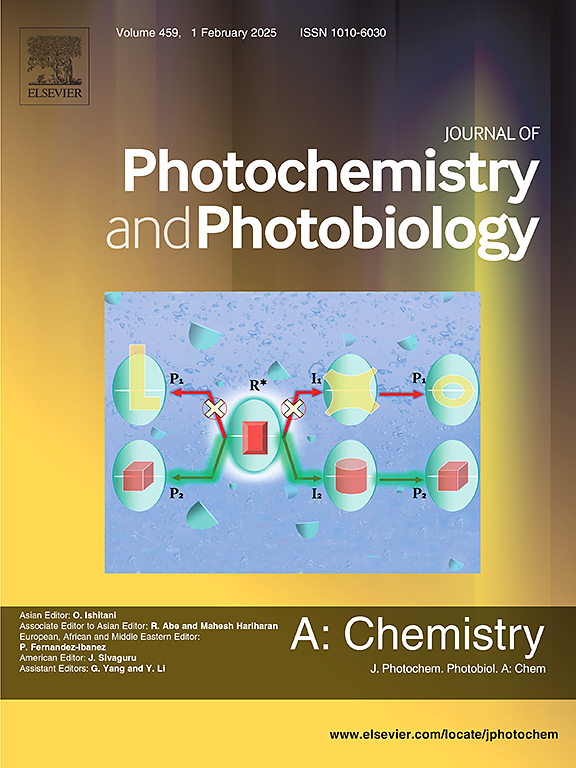Construction and application of Z-scheme heterojunction MOF@COF core-shell materials: Efficient adsorption and synergistic photocatalytic removal of high-concentration organic pollutants
IF 4.7
3区 化学
Q2 CHEMISTRY, PHYSICAL
Journal of Photochemistry and Photobiology A-chemistry
Pub Date : 2025-06-07
DOI:10.1016/j.jphotochem.2025.116554
引用次数: 0
Abstract
High concentrations of organic pollutants have become a significant environmental issue worldwide. In this study, a hybrid material of metal–organic framework (MOF) and covalent organic framework (COF) was synthesized by covalently modifying NH2-MIL-125(Ti) with the COF monomers 1,3,5-tri(4-aminophenyl)benzene (TAPB) and 2,5-di(allyloxy)benzaldehyde (TBAB) via an acetic acid-catalyzed reaction, named NH2-MIL-125(Ti)@TAPB-TBAB (NMTT). The resulting NMTT material inherited the advantages of both MOF and COF, including good crystallinity, large surface area, porous structure, and strong visible light absorption capacity. The prepared MOF@COF hybrid demonstrated excellent adsorption performance and photocatalytic activity. Experimental results showed that NMTT was highly effective in removing high concentrations of rhodamine B (RhB) dye, with a removal rate of 100 % for 50 ppm RhB at pH = 5, significantly outperforming both NH2-MIL-125(Ti) and TAPB-TBAB. Additionally, NMTT showed broad applicability for the removal of other high-concentration organic pollutants. Through systematic characterization and experimental analysis, a potential Z-scheme heterojunction reaction mechanism was proposed. This study provides new insights for the development of novel MOF@COF composite materials and presents promising potential for environmental remediation of high-concentration organic pollutants.

z型异质结MOF@COF核壳材料的构建与应用:高效吸附与协同光催化去除高浓度有机污染物
高浓度有机污染物已成为世界性的重大环境问题。在本研究中,通过乙酸催化反应,以COF单体1,3,5-三(4-氨基苯基)苯(TAPB)和2,5-二(烯丙氧基)苯甲醛(TBAB)对NH2-MIL-125(Ti)进行共价修饰,合成了金属-有机骨架(MOF)和共价有机骨架(COF)的杂化材料,命名为NH2-MIL-125(Ti)@TAPB-TBAB (NMTT)。所制备的NMTT材料继承了MOF和COF的优点,结晶度好,比表面积大,多孔结构,可见光吸收能力强。制备的MOF@COF杂化物具有优异的吸附性能和光催化活性。实验结果表明,在pH = 5条件下,NMTT对高浓度罗丹明B (RhB)染料的去除率为100%,显著优于NH2-MIL-125(Ti)和TAPB-TBAB。此外,NMTT对其他高浓度有机污染物的去除也具有广泛的适用性。通过系统表征和实验分析,提出了一种潜在的z型异质结反应机理。该研究为新型MOF@COF复合材料的开发提供了新的见解,并为高浓度有机污染物的环境修复提供了广阔的前景。
本文章由计算机程序翻译,如有差异,请以英文原文为准。
求助全文
约1分钟内获得全文
求助全文
来源期刊
CiteScore
7.90
自引率
7.00%
发文量
580
审稿时长
48 days
期刊介绍:
JPPA publishes the results of fundamental studies on all aspects of chemical phenomena induced by interactions between light and molecules/matter of all kinds.
All systems capable of being described at the molecular or integrated multimolecular level are appropriate for the journal. This includes all molecular chemical species as well as biomolecular, supramolecular, polymer and other macromolecular systems, as well as solid state photochemistry. In addition, the journal publishes studies of semiconductor and other photoactive organic and inorganic materials, photocatalysis (organic, inorganic, supramolecular and superconductor).
The scope includes condensed and gas phase photochemistry, as well as synchrotron radiation chemistry. A broad range of processes and techniques in photochemistry are covered such as light induced energy, electron and proton transfer; nonlinear photochemical behavior; mechanistic investigation of photochemical reactions and identification of the products of photochemical reactions; quantum yield determinations and measurements of rate constants for primary and secondary photochemical processes; steady-state and time-resolved emission, ultrafast spectroscopic methods, single molecule spectroscopy, time resolved X-ray diffraction, luminescence microscopy, and scattering spectroscopy applied to photochemistry. Papers in emerging and applied areas such as luminescent sensors, electroluminescence, solar energy conversion, atmospheric photochemistry, environmental remediation, and related photocatalytic chemistry are also welcome.

 求助内容:
求助内容: 应助结果提醒方式:
应助结果提醒方式:


